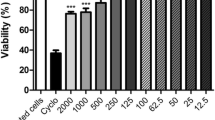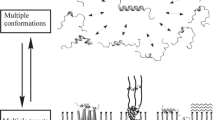Abstract.
Cobra venom cytotoxins (CTX) have been shown to disrupt cells as different as immunocytes, skeletal myocytes, erythrocytes and tumor cells. Nevertheless, even subpopulations of tumor cells are differentially susceptible to CTX by an order of magnitude. In the present study, our objective was to compare CTX-specific binding with cytolytic potency for two disparate cell types in vitro. We investigated the lytic activity of cytotoxin-III from Naja naja atra (NNA, fraction D) using heart cells and human leukemic T-cells (CEM cells). For both cell types, 50% cytolysis, assessed by tetrazolium dye conversion, occurred with μm concentrations of toxin (EC50= 2.2 μm). We examined the binding of radiolabeled CTX III to both heart cells and CEM cells and found the apparent dissociation constant (K Dapp) to be 0.69 μm and 0.75 μm, for CEM and heart cells respectively. The B max for the CEM cells was 1.0 fmoles/cell and that for heart cells was 5.2 fmoles/cell, both exhibiting positive cooperativity between the sites (Hill coefficients 1.4, T-cells; 1.6, heart). Relatively modest dissociation constants plus high numbers of binding sites per cell are consistent with a model of CTX binding to plasma membranes by interaction with phospholipids in the bilayer. Our results suggest that the lytic activity of this cytotoxin follows its binding to a population of sites on the cells in a cooperative fashion.
Similar content being viewed by others
Author information
Authors and Affiliations
Additional information
Received: 8 May 1995/Revised: 17 November 1995
Rights and permissions
About this article
Cite this article
Stevens-Truss, R., Messer, Jr., W. & Hinman, C. Heart and T-Lymphocyte Cell Surfaces Both Exhibit Positive Cooperativity in Binding a Membrane-Lytic Toxin. J. Membrane Biol. 150, 113–122 (1996). https://doi.org/10.1007/s002329900035
Issue Date:
DOI: https://doi.org/10.1007/s002329900035




